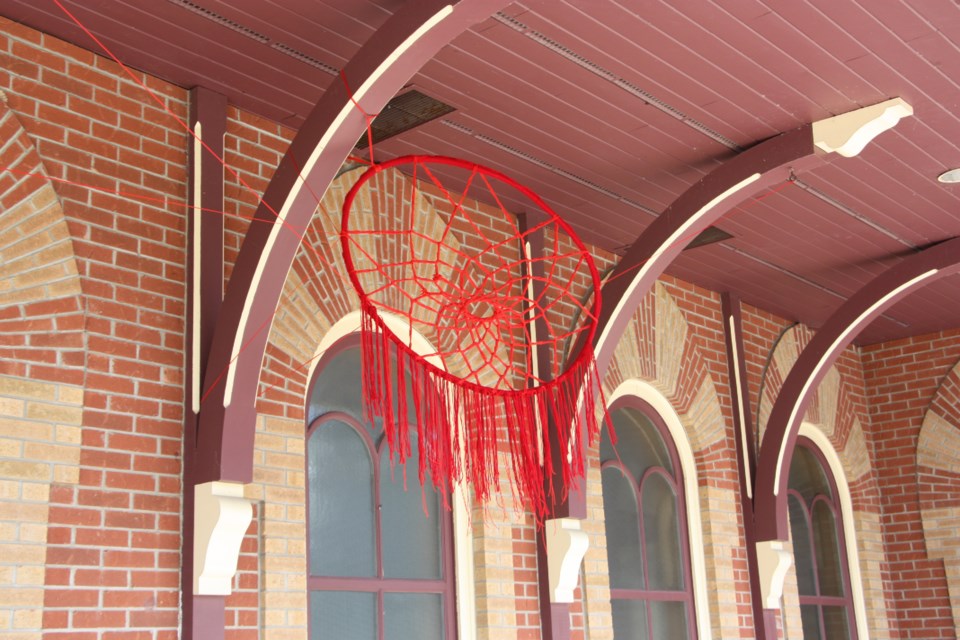The medium is the message for a new art installation at Collingwood Museum.
Every strand of red string weaved, knotted, crocheted and knitted into a sculpture-like creation by Métis artist Tracey-Mae Chambers is wound around the goal of decolonization.
Chambers was in Collingwood on Saturday, Aug. 13 to hang her 105th installation in the cross-nation #hopeandhealingcanada project she began in July 2021.
The sculpture installation artist said the discovery of unmarked graves and buried children at former residential school sites “f***ed with her head.”
“I felt such a massive amount of anger,” she said. “But I wanted something to start a conversation.”
She thought of string, and its inherent ability to connect.
“If you sew something, and you cut one string … you can pull the whole thing apart just by pulling one string,” said Chambers. “A community is a woven set of individuals, and if you separate those, it’s very difficult to put them back together.”
Each of the installations is created specifically for the site, using some pre-made pieces that were crocheted, knitted, knotted, or otherwise weaved together.
“I learned the techniques for the project,” said Chambers. “It’s not my thing, but it’s the right thing for this project.”
She chose the colour red because it has been used as a racial slur, but also because of its association with blood, power, anger and other intense emotions.
The project includes installations in Canada, and later in the USA, that are site-specific with locations like residential school historical sites, cultural centres, museums, art galleries, and other public spaces.
Chambers said the sites were chosen because they can be places where a settler’s narrative or settler’s history is told.
“This project asks ‘how do we represent everybody within the space?’” said Chambers. “Projects like this are meant to start conversations between settlers and Indigenous folks. They’re difficult conversations.”
The difficulty of hope and healing, and of decolonization, is reflected in the nature of string art.
“I unravel the string to begin with, and then I ball it up … it’s that motion of construct and deconstruct, construct and deconstruct,” said Chambers.
The installations typically stay up for about three months, some indoors, some outdoors, and the string will sustain varying degrees of degradation from weather or sunlight. But Chambers won’t toss the worn string. She makes a point of reusing the materials.
“It would be a capitalist thing for me to throw it out … we’ve been fed that too long, that we can just ‘buy another one’. That’s deconstruction and construction as well. When I get the pieces back, I make something new and they go to a different place.”
A large flower installation Chambers put up at Shingwauk Residential School Centre at Algoma University in Sault Ste. Marie hung in the former school church. The Indigenous boys forced to attend the residential school were also used to make the furniture for the church.
Once the string flower came down from its place in front of the stained glass windows at Shingwauk, Chambers hung it with several other pieces in Quebec City.
“The stories from each place are physically carried with the work,” said Chambers. “I don’t care that the work will become faded by the sun in some places, that’s part of it. What better way to illustrate that part of capitalism is also part of decolonizing?”
She points to the example of a dreamcatcher, which is supposed to be made for a child from natural materials that will degrade as the child grows up.
“As the child ages, the dreamcatcher falls apart,” said Chambers. “A child grows out of night terrors and fear, you hope, and they don’t need a dreamcatcher anymore.”
Chambers currently lives in Beamsville. Her family is from and some still reside in the traditional Métis community in Sault Ste. Marie and Penetanguishene
The installation at the Collingwood Museum will stay in place until about November.
You can read more and see photos of other installations in the #hopeandhealingcanada project on Chambers’ website at traceymae.com.



